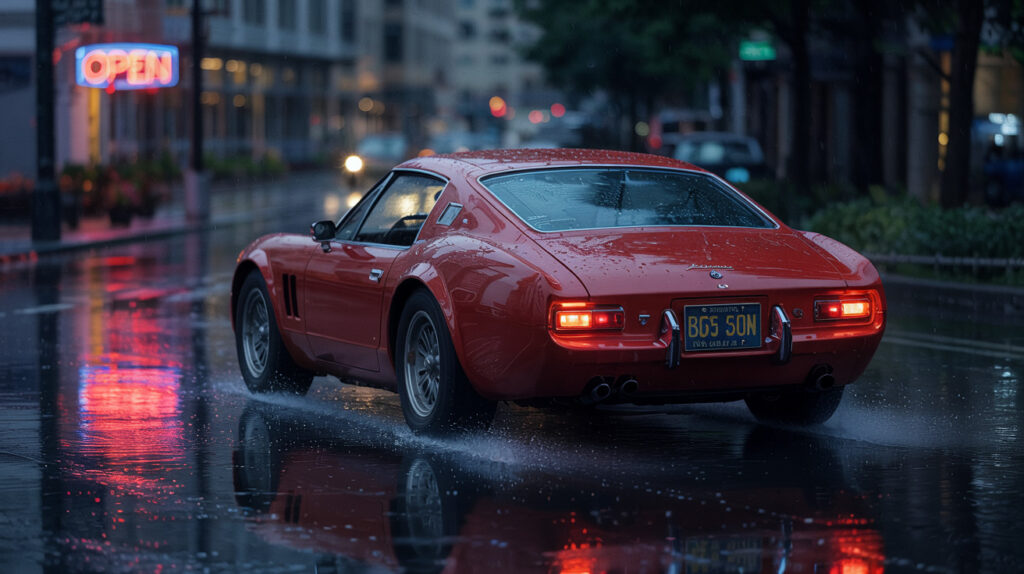So, you’re in a modern car and maybe you feel pretty invincible when you’re driving in the rain?
Think again…
Modern cars are packed with safety systems that can help you stay in control in the rain –
but only if you use them correctly.
Read on to discover how different braking and stability technologies work when the road is wet.
Anti-lock Braking System (ABS)
ABS prevents your wheels from locking during heavy braking. In an emergency stop, the right move is simple: press the brake pedal firmly and keep it down. Don’t pump the brakes – ABS does that automatically. You might feel a pulsing or hear grinding noises from the pedal. That’s normal. It’s the system rapidly applying and releasing brake pressure to maintain control.
ABS lets you steer while braking, which is a huge advantage on wet roads. But it doesn’t make you stop faster. In fact, on very slippery surfaces, it can slightly increase stopping distance. Its purpose is to prevent skids – not to let you drive closer or faster.
Cadence Braking (non-ABS cars)
If you’re in an older car without ABS, you’ll need to pump the brakes yourself in a skid. This is called cadence braking – press firmly until just before lockup, release, and repeat. It’s hard to do perfectly and a big reason why ABS became standard. If you’re not trained in it, the basic advice is: release the brake when skidding, then reapply gently. Most drivers won’t need this, but it’s useful to know – especially if you drive classic cars or rent older vehicles abroad.
Stability and traction control
ESC (Electronic Stability Control) and traction control are your silent helpers in the background. Traction control stops wheelspin if you accelerate too quickly on a wet surface. ESC senses if your car is starting to skid and gently brakes individual wheels to help correct it. For example, in a corner, ESC might brake the inside wheels to bring the car back into line. These systems are great – but not magic. If you drive too fast into a bend in the rain, no tech can override the laws of physics. Always leave these systems on unless you have a very specific reason to turn them off. If the ESC light flashes, it means it’s stepping in – and that you’re pushing the car too hard for the conditions.
Regenerative braking (EVs and hybrids)
In electric and hybrid cars, lifting off the accelerator often slows the car using regenerative braking. That can feel like you’ve lightly pressed the brakes – or even more, depending on the settings. In wet weather, sudden regen can cause skidding if it’s too aggressive. Many EVs let you turn it down for slippery conditions
As always, smooth driving helps – ease off the pedal gently, especially on corners. If your EV uses strong one-pedal driving, you may need to feather the accelerator to avoid braking too sharply downhill. Also, brake lights may not come on during regen – tap the pedal lightly if needed to alert drivers behind.
Engine braking and gears
In manual cars, downshifting to a lower gear lets the engine slow you down. This is especially helpful downhill or when brakes are wet. It’s gentler than using the brakes alone and reduces the risk of skids. In automatics, you can often use paddles or “L” mode to get the same effect. Just don’t shift too suddenly – it can jolt the wheels and cause a loss of traction. Also, avoid coasting in neutral. You lose both engine braking and full control.
Wet brakes after deep water
If you drive through a big puddle or flood, your brakes might not work properly right away. As soon as it’s safe, gently press the brake pedal to test them. If they feel weak, keep braking lightly while driving slowly – the friction will help dry them out. And remember: don’t open the bonnet if you break down in heavy rain. Wet electrics can make a bad situation worse.
In short: trust ABS and brake firmly if needed. Keep traction and stability systems on. Adjust regenerative braking in the wet. Use gears to help control speed – and if your brakes get soaked, dry them with gentle pressure. No technology replaces caution, but used properly, these systems make a real difference when the rain starts falling.
Vehicle Maintenance for Wet-Weather Braking
The best braking system in the world won’t save you if your tyres are bald or your wipers barely work. In wet weather, staying safe starts with how well your car is maintained. Here’s what to check before the rain comes.
Tyres
Tyres are your only contact with the road – so their condition really matters. UK law requires a minimum tread depth of 1.6 mm across the central three-quarters of the tyre. But grip in the wet drops off sharply under 3 mm. Most experts recommend changing tyres before they wear past that point.
Check for uneven wear, bulges, or sidewall damage, and make sure pressures match the manufacturer’s recommendation. Underinflated tyres increase the risk of aquaplaning and wear out faster. If you live in a wet region, consider switching to all-season or winter tyres during colder months – their tread patterns and rubber compounds are better suited to damp roads.
Brakes
Your braking system must be reliable. That means brake pads and discs in good shape, with no signs of excessive wear or warping. Worn discs or sticky calipers can cause one-sided braking, which may trigger a skid. Have your brakes checked regularly, especially if you notice pulling, squealing, or reduced braking power. Brake fluid should be replaced every two years to prevent moisture buildup, which can cause brake fade under stress. If your ABS warning light is on, get it checked before it’s needed in an emergency.
Lights and Wipers
“See and be seen” is key when roads are wet. Check that all lights work – headlights, indicators, brake lights, fog lamps – and clean them often. Dirty lenses reduce visibility, especially in murky weather. Replace wiper blades if they streak or squeak. Don’t forget the rear wiper, if you have one. Keep your screenwash topped up with the right fluid, and use your demisters and air-con to keep windows clear. Fogged-up windows mean delayed reactions.
Suspension and alignment
Your suspension keeps your tyres in contact with the road. Worn shocks can cause the wheels to bounce over bumps, reducing grip. If your car feels floaty or continues bouncing after a bump, have the suspension checked. Likewise, bad alignment or unbalanced wheels cause uneven tyre wear, as well as excessive tyre wear – and can pull the car to one side under braking – not what you want in the wet.
Glass and mirrors
Good visibility in all directions makes for safer decisions. Clean your mirrors regularly and consider using a water-repellent treatment on your windscreen. A clear rearview might help you decide to brake gently rather than risk someone rear-ending you. And make sure windscreen cracks aren’t obstructing your view or contributing to glare at night.
Other systems
Make sure features like fog lights, heaters, air con, and rain sensors are all working properly. A weak battery can mean dim headlights and slow wipers – a recipe for danger when visibility already isn’t great.
In short: Good tyres, strong brakes, clean lights, and clear vision all add up to safer braking in the rain. Think of maintenance as preparation – it’s not just for the garage, it’s for the moment you really need to stop in a hurry.
Last updated: 23/06/2025


